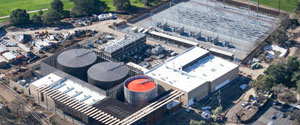In October 2009, Stanford University released a comprehensive and long-range Energy and Climate Action plan aimed at maximizing energy efficiency and utilizing clean, renewable energy on campus. The plan includes high-efficiency standards for new buildings; continued efficiency improvements for existing buildings; and a cutting-edge energy supply system known as the Stanford Energy System Innovations (SESI) project, which the board of trustees approved in December 2011.
SESI represents a transformation of the university energy supply from a 100 percent fossil-fuel-based combined heat and power (CHP) plant to grid-sourced electricity and a more efficient electric heat recovery system. In 2013, Stanford’s greenhouse gas (GHG) emissions totaled 210,000 metric tons. This new system, along with Stanford’s solar procurement, is anticipated to reduce campus emissions to 67,000 metric tons, approximately 68 percent below current levels, and save 15 percent of campus potable water.
THE SESI PROJECT
 Since 1987, Stanford relied on the natural gas-fired CHP plant for virtually all of its energy demand. Although efficient, its fossil-fuel-based source caused the CHP plant to produce 90 percent of Stanford’s GHG emissions and consume 25 percent of the campus’ potable water supply. As a result, Stanford’s GHG reduction strategy focused primarily on transforming the university’s energy supply through a new Central Energy Facility (CEF).
Since 1987, Stanford relied on the natural gas-fired CHP plant for virtually all of its energy demand. Although efficient, its fossil-fuel-based source caused the CHP plant to produce 90 percent of Stanford’s GHG emissions and consume 25 percent of the campus’ potable water supply. As a result, Stanford’s GHG reduction strategy focused primarily on transforming the university’s energy supply through a new Central Energy Facility (CEF).
The new CEF includes three large water tanks for thermal energy storage and a high voltage substation that receives electricity from the grid. A key feature of the CEF is an innovative heat recovery system that takes advantage of Stanford’s overlap in heating and cooling needs. In addition to the CEF, the SESI project converted the heat supply of all buildings from steam to hot water. This new system is 70 percent more efficient than the CHP plant. The efficiencies gained from the new CEF and hot water conversion, along with Stanford’s commitment to procure much of its electricity from solar, are expected to reduce the university’s overall GHG emissions by about two-thirds.
IMPLEMENTATION
Stanford completed conversion of over 20 miles of steam pipelines to hot-water pipelines across the entire campus in October 2014 and upgraded 155 buildings to hot water piping in March 2015. The work was sequenced in multiple phases to minimize disruption to the campus. As each phase of piping and building conversion was completed, that section of campus moved off steam to hot water via a regional heat exchanger that converted steam from the existing cogeneration plant to hot water at a district level. A full transition from the CHP plant to the new CEF took place in April 2015, allowing the regional heat exchange stations to be removed, and the CHP plant to be decommissioned and removed to make way for new academic buildings within the campus core.
HEAT RECOVERY
The Stanford campus has a 70 percent real-time overlap of demand for heating and cooling. This presents the opportunity for heat recovery, using waste heat collected by the chilled-water system to meet the university’s concurrent heating need. The new heat recovery system collects waste heat from buildings via a chilled-water loop and captures it at the CEF for reuse, eliminating the use of cooling towers to discharge the heat. Instead, heat recovery chillers move waste heat collected from the chilled-water loop to a new hot-water loop that distributes heat to the buildings. The heat recovery system meets 93 percent of the heating load on campus with waste heat and reduces total campus water consumption by 15 percent.
Although the heat recovery system had a modestly higher capital cost than a conventional boiler and chiller plant design, it had a lower upfront cost than a new CHP plant, has the lowest lifecycle cost of all options, and is expected to pay for itself many times over in the coming years. At the same time, it will position Stanford as a national leader in energy efficiency and carbon reduction.
PREDICTIVE CONTROL
The facility’s complex, yet repetitive, operations allowed for a computerized model that could automate much of the day-to-day functionality. The Central Energy Plant Optimization Model (CEPOM) is a patented technology developed by Stanford that creates a 10-day, forward-looking hourly plan for optimal operation of the CEF. The model takes into account a multitude of factors, including weather, cost of electricity and natural gas, thermal capacity, and equipment availability to project an optimal operating plan for the facility.
For more information about the SESI project, click here.
Publication date: 6/22/2015
Want more HVAC industry news and information? Join The NEWS on Facebook, Twitter, and LinkedIn today!


Report Abusive Comment